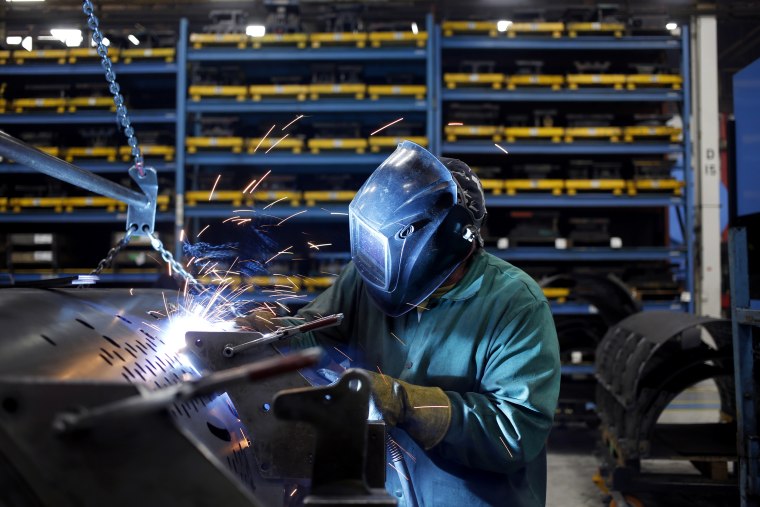With more and more Americans entering a booming labor market and unemployment hovering at 50-year lows, 2019 would seem to be the year of the worker. Wage growth has started to improve, hitting 3.2 percent over the past year, and government data shows there are more job openings than people looking for work.
Ironically, those conditions might mean a better year for those who already have jobs and might be considering a change. Those who have been without jobs, however, face the dual problems of missing skills and disadvantageous location. In addition, the lack of available workers could put the brakes on economic growth.
There's been an employment boom, with January likely to be the hundredth consecutive month of job growth, according to Becky Frankiewicz, president of North America for ManpowerGroup. "We're seeing growth across all sectors" and types of work, she told NBC News. In a recent survey, the company found that among the top positions needed were skilled building trades, drivers, and sales representatives. "These aren't your future AI jobs."
However, technology has again changed the nature of work. Increasingly, workers need specialized technical knowledge. "We don't have enough labor and we don't have enough with skilled capabilities," Frankiewicz said.
The shortage is hitting many industries hard. The National Kitchen & Bath Association, an industry group for remodelers, surveyed its members and found that 74 percent had difficulty in recruiting labor. "Nearly 50 percent of our members say they're having trouble even finding professionals" like architects, said CEO Bill Darcy. The organization's members say the lack of available help causes delays on 30 percent of their jobs.
"We can't remember a busier period," said Joanie Courtney, a vice president of industrial staffing firm EmployBridge. "We have about 90,000 temporary employees working every single week," including drivers, warehouses, and call centers.
Companies find they can't necessarily do as they once did, which is look for people whose experience and knowledge are exact matches for corporate needs. Fewer high schools have classes that address many types of work that are in critical shortage. For example, Darcy says that only one person enters the building trades for each five that leave.
People who might go into high-tech manufacturing may not have a clear course of training to gain the necessary skills. And in some areas like food service and hospitality, automation increasingly replaces people at tasks. But the economy has been doing well under many measures and so education and training haven't been a first priority for governments.
"This is when policymakers should think of broad retraining programs," said Joe Brusuelas, chief economist at RSM US.
Until then, private industry will have to pick up the slack. "Three years ago, 12 percent of employers in the U.S. were providing more training and development," Frankiewicz said. "Today, half are investing in learning platforms to build their talent pipeline."
Corporations will have to look more at the changing nature of jobs and, rather than laying off people whose job has been outsourced or automated, prepare them for something else.
Furthermore, a focus on average numbers, like unemployment figures, can miss the variations that leave many without ready access to jobs. Across metropolitan areas, the percentage of jobs that don't require a bachelor's degree that are good or promising ranges from 35 percent in Spokane, Washington, to 9 percent in Washington, D.C., according to a recent Brookings Institution study.
Similarly, unemployment rates vary substantially by region. "While it’s great to see the official unemployment rate at 3.9 percent, this figure doesn’t tell the full story," said Marie Trzupek Lynch, chief executive officer at Skills for Chicagoland’s Future, a public-private partnership that tries to place unemployed and underemployed people in jobs. The organization works in Chicago neighborhoods with unemployment as high as 16.4 percent.
Cities and states should focus on broader types of employment to extend economic improvement to every part of society, instead of trying to attract the big names such as Amazon.
Until then, "You have companies making compromises they never thought they'd make before on the quality of the candidate or completeness of the skill set," said David Lewis, CEO of human resources outsourcer and consultancy OperationsInc.
